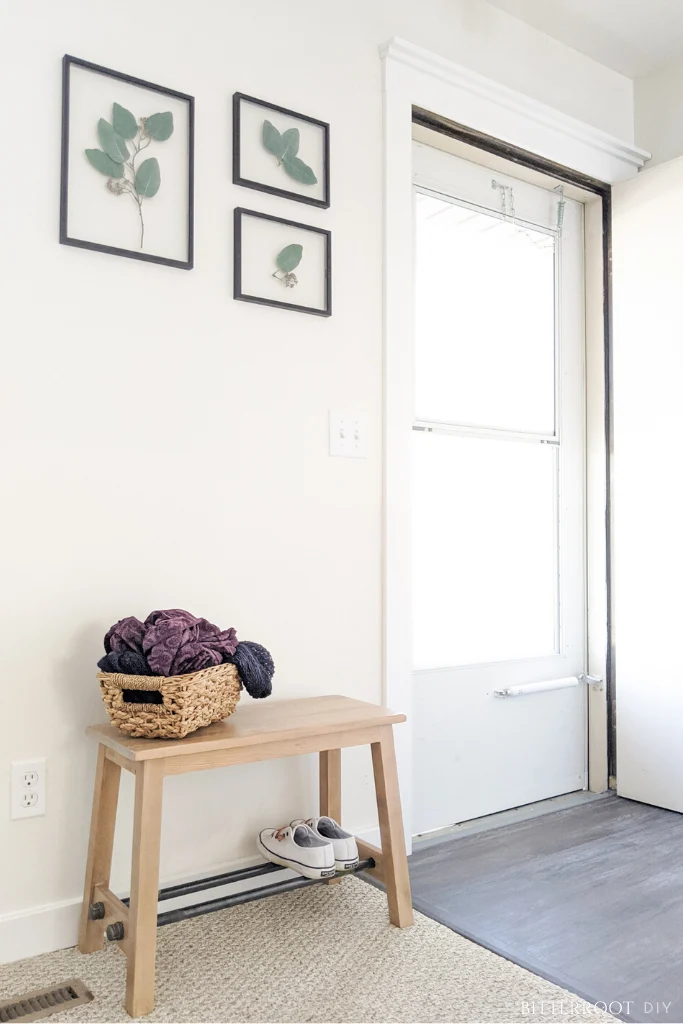Build a modern farmhouse DIY entryway bench with this tutorial and plan set.

This post contains affiliate links. If you make a purchase from one of the links, I may make a small commission at NO EXTRA COST to you. This helps keep the tutorials and plans free here at Bitterroot DIY. Thank you for your support! See my full disclosure here.
Over the past few weeks, I’ve been working on a small entryway makeover. I redid the flooring, installed board and batten along the half wall, redid the trim, and added a few new accessories. But one of my favorite parts of the project was building this simple DIY entryway bench. It’s a great addition for the entryway and a handy spot for getting shoes on and off.
Enjoy the plans!
TOOLS & SUPPLIES
- Miter Saw
- Drill
- 5/8″ Spade Bit (or 5/8″ Forstner Bit)
- Kreg Pocket Hole Jig
- 1 1/4″ Pocket Hole Screws
- 3/4″ Corner Braces
- Two 24″ Black Steel Pipes (1/2″)
- Four 1/2″ Pipe Caps (that link is to a pace of 10, but you only need 4)
- Tape Measure
- Clamps
- Wood Glue
- Pre-Stain
- White Wash Stain
- Early American Stain
- Water Based Polyurethane in Glossy
- Stain Pads
- Polyurethane Brush
- Speed Square
- Pencil
- Safety Glasses
- Ear Protection
Lumber:
- 1 | 2 x 2 @ 8′
- 1 | 1 x 2 @ 8′
- 1 | 1 x 3 @ 6′ (you only need about 2′ but 6′ is the smallest they usually sell in-store)
- 1 | 1 x 4 @ 8″
Cuts:
- 2 | 1 x 2 @ 6″ on the short side with perpendicular 5 degree miter (top frame sides)
- 2 | 1 x 2 @ 19″ on the short side with perpendicular 5 degree miter (top frame front&back)
- 2 | 1 x 3 @ 8 1/2″ on the long side with perpendicular 5 degree miter (bottom frame sides)
- 4 | 1 x 4 @ 24″ (seat)
- 4 | 2 x 2 @ 17 7/8″ with parallel 5 degree miter and bevel (legs)
**To cut the legs, set your saw to BOTH a 5 degree miter AND a 5 degree bevel. Cut the end off the first 2×2 so you have the correct starting angle. Measure out 17 7/8″ along the top side of the 2×2, slide it straight down (don’t flip it around or rotate it), and make the cut at your mark. Since the miter and bevel are parallel on both the top and bottom of the legs, all you have to do is slide the 2×2 along as you make your cuts. No need to rotate or flip.

I also recommend marking the long corner as you go. It’s a smart trick I picked up from Ana White and is super handy during assembly. The 5 degree angle is pretty small, so it’s hard to see if you don’t mark it. The long corners face towards the inside of the bench.

I did a few practice runs the first time I cut legs like this just to help wrap my mind around it. If this is your first time cutting both a miter and bevel, I recommend practicing on some scrap wood first to see how it works.
Other than that, everything is pretty straightforward.
Step 1.
Assemble the side frames first. Use wood glue and 1 1/4″ pocket hole screws to attach the 1×2 top frame to the legs. Face the pocket holes towards the inside of the bench and use two pocket holes per side of the 1×2. I positioned the 1×2 so it was flush with the outside of the legs, but you can center it if you prefer.

Next, attach the 1×3 bottom frame. Center the 1×3 on the legs and attach with wood glue and 1 1/4″ pocket hole screws. Again, use two pocket holes per side and face them towards the inside of the bench.
Build two frames.

Step 2.
Attach the side frames together with the 1×2 front and back frames. Use wood glue and two 1 1/4″ pocket hole screws on each side to attach the 1x2s to the legs. Face the pocket holes towards the inside of the bench – same as the side frames.

I positioned the front and back 1×2 frame pieces flush with the outsides of the legs (same as the side frame), but, again, you can center them on the legs if you prefer.
Step 3.
Now that you have most of the frame assembled, use a 5/8″ spade bit (or 5/8″ forstner bit) to drill through the 1x3s for the bottom pipes.

**Tip: clamp a scrap board to the back of the 1×3 when you drill through to prevent tear out along the back.
Leave the pipes out for now – you’ll stain it before putting the pipes in.
Step 4.
Build the bench seat. Use wood glue and 1 1/4″ pocket hole screws to attach the bench seat boards to each other. Stagger the pocket holes along the 1x4s as shown for a solid connection:

Step 5.
Sand and stain both the bench base and seat. I used my new favorite custom stain combo – pre-stain, white wash pickling, and early american. I sealed it with glossy water based polyurethane.
Step 6.
Once the finish is completely dry, string the black pipes through the bottom of the bench and tighten the caps on the ends.

I built this bench to fit the 24″ black pipes that Home Depot had stocked. They carry a few different lengths already cut and threaded, so you could definitely adjust the bench dimensions for bigger or smaller pipes. Home Depot will also cut and thread pipes in-store if you prefer a custom size.
Step 7.
Lastly, center the bench seat over the frame and attach it to the frame. I used four small corner braces to attach the seat. The corner braces allow the seat and frame to move separately as the wood expands and contracts so it won’t get pulled off-square. Another common way to attach tabletops or bench tops is Figure 8 fasteners.

And there you have it!

Please let me know if you have any questions and I’ll get back to you as soon as possible!
**Update: head over to see the full DIY entryway final reveal.

Thanks for stopping by!
For more project ideas, you can find me on Pinterest. And to stay up to date with the latest shenanigans, follow me on Instagram.


